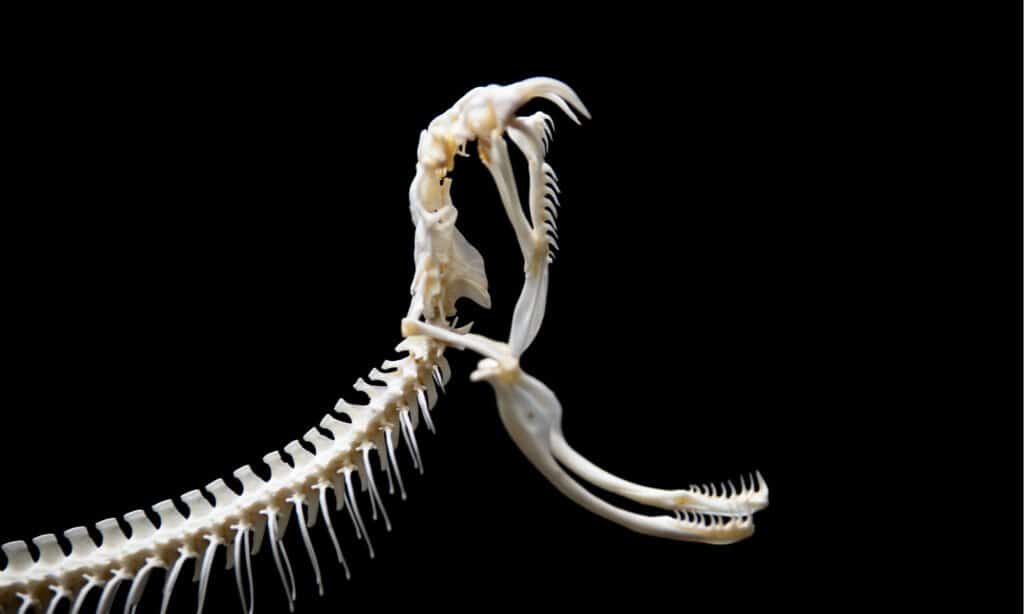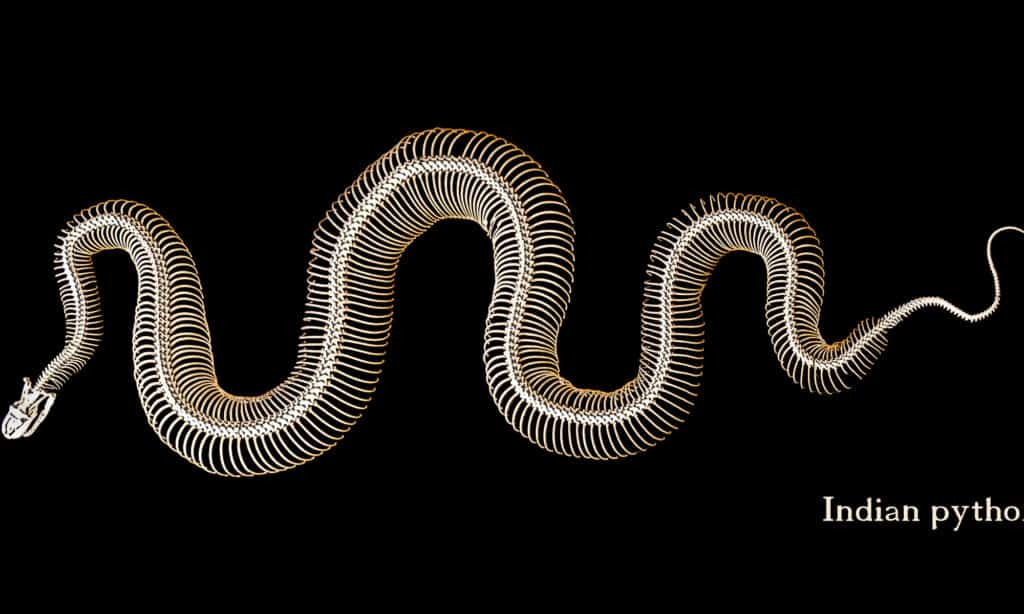Snakes are some of the most interesting animals on the planet! There are over 4,000 snake species in the world, all with their own special adaptations and strategies for survival. One that makes snakes so special is their unique skeletons. Without major evolutionary adaptations, snakes wouldn’t look like they do today. Let’s discover and learn about snake skeletons: What makes them so unique?
What Makes Snake Skeletons Unique?

Snake skeletons have an incredible number of ribs compared to other animals like mammals.
©iStock.com/undefined undefined
There are quite a few things that make snake skeletons so unique. The major things that separate a snake skeleton from any other mammal or reptile are their number of vertebrae and ribs, their flexible spines, and their lack of almost any other skeletal structure.
These adaptations, combined with a few others, have allowed snakes to have some of the most unique shapes and methods of locomotion on earth. Although it makes them extremely flexible, it also makes them surprisingly delicate because they are almost all spine with a little tail. Let’s take a look at these differences in-depth and discover even more about what makes snake skeletons so unique.
Their Jaws Are Insanely Flexible

Snake don’t unhinge or dislocate their jaws. Instead, their jaws are connected with stretchy ligaments so they can open wide.
©David Herraez Calzada/Shutterstock.com
One of the key factors that have allowed snakes to become such successful hunters is their jaw design. Although the myth says that they unhinge or dislocate their jaw, they don’t.
Depending on the species, many snakes can kill and consume prey larger than their body is wide. This would pose a real problem for a human, so our solution is to cut things up and chew them. A snake’s solution is a bit different.
When a snake catches prey that is significantly larger than their mouth and body, they use a process known as “gaping.” Gaping allows snakes to open their jaws wider than their body so they can swallow prey that they ordinarily wouldn’t be able to.
This process all comes down to the jaw. In humans (and all other mammals), the lower mandible is fused at the front and connected with strong muscles and ligaments to the skull. This allows humans to exert greater strength when we need to do things like chew or bite. For a snake that doesn’t have flat teeth, however, chewing isn’t all that important. Their solution is to have an unfused mandible that is only connected in the front by stretchy ligaments and loosely connected by ligaments in the back. Humans can open their jaw around 26° from a neutral position. A snake, however, can open theirs 160°.
Hundreds of vertebrae

Snakes have hundreds of vertebrae, sometimes reaching 450 in just their body alone.
©iStock.com/Baramee Temboonkiat
One of the other adaptations that snakes have is their many vertebrae. Vertebrae are the bones that vertebrates have along a central spinal cord. Animals that don’t have these bones are known as “invertebrates” and are generally older from an evolutionary perspective (spines are a more recent development on the earth). Snakes are vertebrates, meaning they have a spine and vertebrae. What makes them special is how many vertebrae they have.
Humans have 33 stacked vertebrae that protect our spinal cord and house all the nerves that allow us to move. Snakes have 100-450 vertebrae in their bodies and between 10-205 vertebrae in their tails. With so many vertebrae, snakes have a significantly wider range of motion than a human would.
An easy way to imagine it is to take a stick that has 3 jointed segments. Each joint allows a certain degree of motion, but not a lot. An easy way to give the stick a larger range of motion is to add more joints. A stick with 100 joints would be able to bend further than a stick with 3. At a certain point and with enough joints, you would be able to curl that stick into a circle. For a snake, this is the benefit of having so many vertebrae.
Hundreds of ribs

While humans have 24 ribs, snakes can have
hundreds.©Bildagentur Zoonar GmbH/Shutterstock.com
Although vertebrae make up the most important part of a snake’s skeleton, there is a little more to it. On each vertebra on a snake is a set of ribs, just like a human. Humans have 24 ribs that protect the important organs within, as well as provide structure to house those organs. Snakes have two ribs attached to every single vertebra that they have, meaning that a snake with 200 vertebrae would have 400 ribs.
These small, flexible ribs can stretch and bend to a certain extent, aiding in the snake’s mobility. Additionally, when a snake eats a large meal that is larger than its body is wide, the stomach of the snake can stretch since the ribs are flexible enough to give it extra room. This is easily seen as a large lump on a snake after a large meal.
The only place on a snake that doesn’t have ribs is on its tail. Even though they have vertebrae there, there aren’t any organs to protect, so they aren’t needed!
Strong bones

Snakes need strong bones
in order to provide structure for constricting.
©Hannamariah/Shutterstock.com
One of the key elements to a snake’s success is the bones themselves. One of the main methods of subduing prey for snakes is through constriction. Constriction is a process where a snake wraps itself around its prey and begins to slowly squeeze, tightening its grip each time the prey exhales. This type of hunting requires immense strength in the muscles as well as the bones.
For a boa constrictor or anaconda hunting animals that weigh up to 100 lbs, being able to squeeze the life out of it would require incredibly strong bones and muscles. In a body, the muscles are attached to bones and require them as an anchor. The strength of snake muscles requires a skeleton that can take the stress.
Vestigial legs
Although snakes don’t have legs today, they used to millions of years ago! When we look at a snake, we don’t see any legs, but through careful observation, we can find what used to be legs a long time ago. Known as “vestigial” legs, some snakes use these small protrusions to get a grip on potential mates, namely pythons and boas.
The photo featured at the top of this post is © gabor_szikora/Shutterstock.com
Discover the "Monster" Snake 5X Bigger than an Anaconda
Every day A-Z Animals sends out some of the most incredible facts in the world from our free newsletter. Want to discover the 10 most beautiful snakes in the world, a "snake island" where you're never more than 3 feet from danger, or a "monster" snake 5X larger than an anaconda? Then sign up right now and you'll start receiving our daily newsletter absolutely free.
Thank you for reading! Have some feedback for us? Contact the AZ Animals editorial team.






